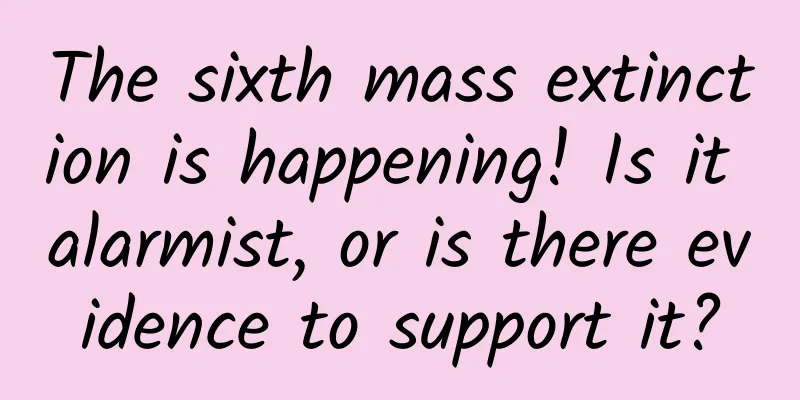The sixth mass extinction is happening! Is it alarmist, or is there evidence to support it?

|
Written by: Wu Tingting Editor: Kou Jianchao Layout: Li Xuewei At present, severe global ecological and environmental problems have become an international issue. Whether it is greenhouse gas emissions, pollution control, or biodiversity issues, they are all topics that are closely related to the public. In particular, the news that the "sixth mass extinction is coming" is worrying. So, is this true or false? Is there any scientific basis for it? Recently, a team of biologists from the University of Hawai'i at Mānoa and the Muséum National d'Histoire Naturelle in Paris, France, conducted research on the "sixth mass extinction" and found that since 1500, 7.5%-13% of the 2 million known species on Earth may have become extinct; among them, island species have been much more affected than continental species. Therefore, experts believe that the sixth mass extinction has begun, and unlike the previous five which were caused by extreme natural phenomena, this large-scale species extinction is caused by human activities. The relevant research paper was published in the scientific journal Biological Reviews under the title “The Sixth Mass Extinction: fact, fiction or speculation?” The 'Sixth Mass Extinction' is Underway Mass extinction refers to the large-scale extinction of species in a short period of time. Once it occurs, many different biological groups often become extinct together. Large-scale cluster extinction has a certain periodicity and occurs approximately once every 62 million years. It is currently recognized that five mass extinctions have occurred on Earth, and humans had not yet appeared at that time. And now, many biologists say that humans are likely to face such a "catastrophe." In order to study whether the "sixth mass extinction" is happening, the research team focused on the extinction of invertebrates, which account for 95-97% of known animal species. In addition, they believe that many species on Earth may have become extinct before they are discovered by humans, and invertebrates will leave their shells even after death, so investigations on them can obtain more convincing evidence and statistical results. Figure | Shells left by recently extinct land snails in Rurutu (Australis Islands, French Polynesia). (Source: the paper) Therefore, by extrapolating the number of land snail and slug species, the researchers found that since 1500, about 150,000 to 260,000 of the 2 million known species on Earth have become extinct, accounting for 7.5%-13% of the total number of species! This number is much larger than the 882 (0.04%) announced by the International Union for Conservation of Nature (IUCN). "The discovery of a large number of invertebrate extinctions is key to our confirmation of the start of the sixth mass extinction event in Earth's history," said Robert H. Cowie, a research professor at the School of Ocean and Earth Science and Technology (SOEST) and the Pacific Biosciences Research Center, the first author of the paper. However, the situation varies from region to region. For example, the researchers found that although marine species are currently facing major threats, there is no evidence that the crisis is affecting the ocean to the same extent as on land. In addition, island species (such as those on the Hawaiian Islands) have been much more severely affected than mainland species, and plants appear to be going extinct at a lower rate than terrestrial animals. Is it alarmist? Or is there evidence to support it? However, there is currently controversy over whether the "sixth mass extinction" has begun. Some people believe that the current extinction rate is not significantly higher than the natural extinction rate (i.e., the natural extinction of species), so there is no large-scale species extinction. However, researchers have proved in the paper that according to this statistics, the current species extinction rate has reached 150-260 E/MSY (that is, 150-260 species per million will become extinct each year), which is much higher than the 2 E/MSY natural extinction rate previously measured by scientists! The Red List compiled by the International Union for Conservation of Nature (IUCN) in 2020 is widely regarded as the most comprehensive compilation of the conservation status of flora and fauna around the world. Many scientists rely on the data in this list and believe that the "sixth mass extinction" is far from coming. However, the research team found that the list mainly involves species of amphibians, birds, and mammals, which may be biased compared with species classifications in other historical studies. Figure | There is a bias in the species categories in the Red List. (Left) The total number of species in the selected major vertebrate and invertebrate groups in two scientific research papers from 2019 and 2021 is significantly different from the proportion of these species assessed in the Red List (right). (Source: This paper) As Professor Cowie said: “The dramatic increase in species extinction rates and the decline in abundance of many plant and animal populations are well documented, but some people do not believe that these phenomena are linked to mass extinctions. This denial is actually based on a biased view of the crisis that focuses only on mammals and birds and ignores invertebrates.” In addition, some people believe that species reduction is a new natural evolutionary trajectory, because humans are also one of the species and play a natural role in the history of the earth. However, Cowie emphasized: "Humans are the only species that can manipulate the biosphere on a large scale. We are not just a species that evolves under external influences. In contrast, we are the only species that consciously chooses our future and the biodiversity of the earth." The five mass extinctions that have occurred on Earth Throughout history, the Earth has experienced many mass extinction events, which have had a huge impact on biodiversity. The five most famous ones are: The first was the Ordovician-Silurian mass extinction, which occurred at the end of the Ordovician period 440 million years ago, when about 85% of species became extinct. A supernova explosion near the Earth produced a gamma-ray burst that hit the Earth, destroying the Earth's ozone layer, causing a large number of deaths in marine plankton, destroying the basis of the food chain, and causing a great famine. Primitive fish survived and gradually replaced invertebrates to dominate the ocean. The second was the Late Devonian mass extinction, which occurred 370 million years ago, when about 75% of marine life became extinct. The culprit for this mass extinction came from the interior of the Earth - a super mantle plume eruption. 300 billion cubic meters of magma gushed out from underground, causing serious pollution to the seawater. Figure | The overlord of the late Devonian period - Dunkleosteus, 11 meters long, weighing more than 4 tons, with a bite force of 5 tons (Source: bing.com) The third was the Permian-Triassic extinction, which occurred at the end of the Permian period, at the junction of the Paleozoic and Mesozoic eras, 258 to 252 million years ago. Super volcanic eruptions caused the extinction of 90-96% of species, including 96% of marine animals and 70% of terrestrial animals. It is the largest known extinction in history. The fourth mass extinction event was the Triassic-Jurassic mass extinction event, which occurred at the end of the Triassic period of the Mesozoic Era, 201 million years ago, and caused the extinction of 70-75% of species. This event marked the dawn of the dinosaur age, with the extinction of early archosaurs, most synapsids, and large amphibians, allowing dinosaurs to take over the terrestrial world with little competition on land. Crocodiles replaced phytosaurs as the dominant species in freshwater ecosystems. Figure | The extinct phytosaur at the end of the Triassic period - the chiseltooth crocodile (Source: bing.com) The fifth mass extinction was the Cretaceous-Paleogene mass extinction, which occurred at the end of the Cretaceous period of the Mesozoic Era, 66 million years ago, and caused the extinction of 75% of species. An asteroid or comet with a diameter of tens of kilometers hit the Earth, and the radius of the impact crater was as long as 150 kilometers. The dust produced covered the sky and the sun, and the Earth could not see the sun for several years or even more than ten years. This mass extinction led to the extinction of dinosaurs and the rise of mammals. It was actually the mildest of the five mass extinctions. Previously, some people have made comments online, arguing that biodiversity should be manipulated in the interests of humans. But after seeing so many extinction events that are older than the entire history of mankind, who can define the so-called "interests"? Therefore, perhaps our response measures will not have an immediate effect, nor can they reverse the overall trend of species extinction, but we must persist in this effort and continue to create miracles for nature. Otherwise, the arrival of the sixth mass extinction of species will only accelerate. References: https://phys.org/news/2022-01-strong-evidence-sixth-mass-extinction.html https://onlinelibrary.wiley.com/doi/10.1111/brv.12816 Academic headlines |
<<: Doping can turn athletes into super soldiers? Why is it so powerful?
>>: Hot search! Running faster than athletes? This is indispensable for exciting game broadcasts
Recommend
Not as popular as Lei Jun’s Weibo, many car companies were absent from Chengdu, why are large auto shows no longer popular?
The Chengdu Auto Show opened. As the largest auto...
If Facebook becomes like WeChat, Apple will be its strongest rival
Zuckerberg and his Facebook don't want to rem...
AC vs. DC, who will win?
More than 100 years ago, Tesla's alternating ...
Baldness treatment upgraded: With the help of gene editing, hairless mice grow human hair!
Written by: Hao Jing Editor: Kou Jianchao Layout:...
Do you need to disinfect your home every day? Master these 9 points to achieve scientific disinfection!
Source: CCTV News...
How to create creative maternal and child advertising on Douyin? Learn about the 5 key words
How to do maternal and infant marketing on Douyin...
How much does it cost to join the Changge Parent-Child Mini Program? Changge Parent-Child Mini Program Franchise Price Inquiry
Why join the WeChat Mini Program Development Comp...
iOS UI Automation Testing Principles and Application Practices at Trip.com
[[429539]] Preface It has been a year since I joi...
Spy photos of the suspected new generation Giulietta will be released before 2020
Recently, overseas media exposed a group of spy p...
iPhone is also affected. Why can’t fingerprint recognition be performed on sweaty hands?
Fingerprints have become almost synonymous with b...
Vipshop, which has been listed for three years: what efforts have been made in products and operations at each stage
Vipshop has developed rapidly. It was listed on t...
WeChat opens WiFi access
We learned from WeChat that its "WeChat WiFi...
At LeEco's funeral, the institutions and big investors who may be "buried with it"
Before one wave subsides, another wave rises. LeT...
Comprehensively promote international cooperation! Emma's first show at CES, the launch of the new cross-country bike attracted global attention
From January 9th to 12th, the 2024 American Inter...
By mastering these 4 steps, 90% of novices can operate "super users"!
In the second half of the Internet, what you need...









